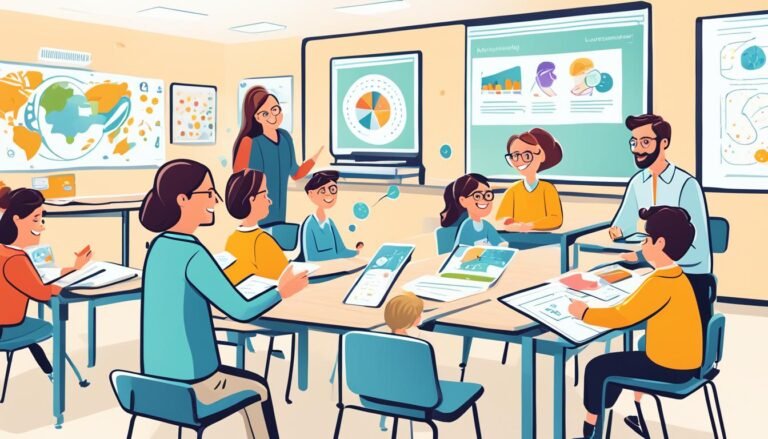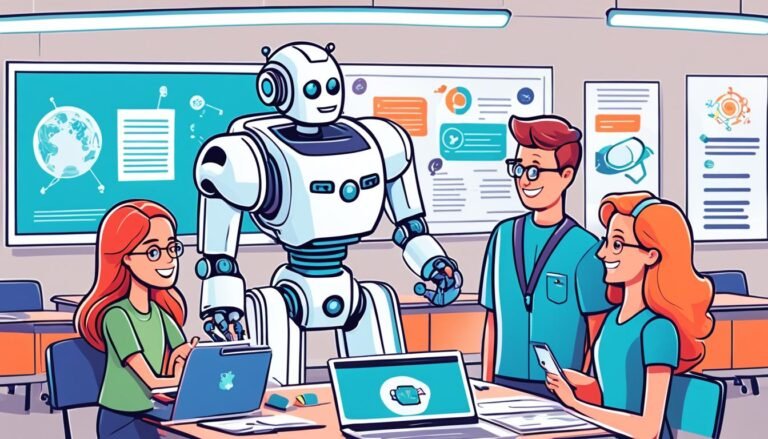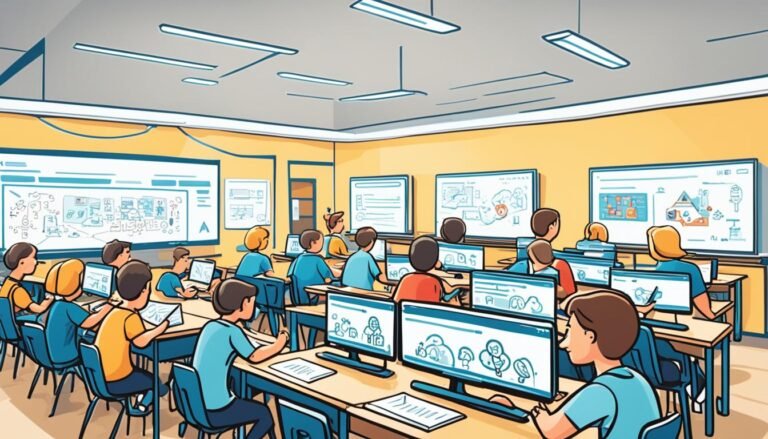AI in Teacher Professional Development: Empowering Educators
Picture a busy workshop filled with teachers from different schools. They are eager to learn new things. They talk excitedly about fresh methods and technologies. Artificial intelligence is on the agenda for one session. The room changes. People are either very interested or a bit uncertain. They realize AI will change teacher learning forever.
Today, teachers must learn about AI. The International Society for Technology in Education (ISTE) says many teachers don’t know enough. Luckily, more professional development courses help. They teach teachers about the latest technology, like AI. Organizations like ISTE, AI4ALL, and Microsoft offer special courses. These help teachers at all levels.
Look at the AI Infused Classroom Summit by Holly Clark. It brought teachers together to explore AI. They learned how AI can make lessons fun and make school work easier. Professional development like this is not just about tools. It’s about making learning better for students who love tech.
There are good reasons for teachers to keep learning about AI. For example, they can save money on AI courses. With such discounts, they can learn a lot without spending too much. Many teachers like these programs. They say they help a lot.
This change to using AI in teacher training is very important. It helps bridge the gap between now and the future of learning. It makes sure teachers are ready to guide students in our digital age.
Key Takeaways
- AI in teacher professional development changes how we teach.
- Professional development focused on AI helps meet new classroom needs.
- Courses and resources from ISTE, AI4ALL, and Microsoft help teachers learn about AI.
- Good discounts are there for teachers wanting to learn about AI.
- Eighteen people say AI training is very valuable.
- AI tools make learning personal and strategies more effective.
- The AI Infused Classroom Summit shows how AI can work in education.
Introduction to AI in Education
Artificial intelligence is changing our classrooms. It gives teachers new ways to make lessons special for each student. As AI grows, we need to learn how to use it well in education.
Understanding the Role of AI in Modern Classrooms
AI makes learning more personal and fun. It changes lessons to fit each student’s needs. For teachers, AI tools create lessons that help every student learn better. The EdTechTeacher AI in Edu Summit shows how AI can change education for the better.
The Need for Technological Proficiency Among Educators
Teachers must know how to use AI to its fullest. They should join training sessions to get better with AI. These sessions teach important AI skills, so teachers can use technology well.
Challenges and Opportunities of AI Integration
AI in education is both hard and full of chances. We must use AI in ways that are fair and right. Teachers and students can gain a lot from AI, such as cool new ways to teach and learn. AI helps students get more involved and creative. It also supports teachers in finding new ways to teach and use helpful technology.
| Program Aspect | Details |
|---|---|
| CE Credits | Can be utilized by educators in some school districts to assist in advancing along their pay scale. Follow a “Pass/Fail” grading system. |
| Program Decision | Must be made prior to starting the program if pursuing CE credentialing. |
| Partial Credit | Not provided for incomplete programs. Full program fee is required after drop deadline. |
| F Grade | Given if CE credits are chosen without successful completion of the program. Shown on permanent Penn transcript. |
| Act 48 Credits | Pennsylvania educators can earn Act 48 credits without registering for CE credits. |
Benefits of AI for Teacher Professional Development
AI is changing the way teachers learn and grow. It uses machine learning to help teachers with their strategies and tasks. This technology gives teachers better ways to teach, manage their work, and get advice that fits their needs.
Enhancing Teaching Strategies
AI tools help teachers understand how students learn. Platforms like Google AI Education and Microsoft help create learning experiences for each student. They also offer quizzes and lesson plans. This allows teachers to teach in different ways, making it easier for every student to learn.
| AI Tool | Application | Benefits |
|---|---|---|
| Generative AI | Creating quizzes, presentations, and worksheets | Enhances diversity in teaching methods |
| Data Analytics Platforms | Analyzing student performance data | Provides tailored instructional strategies |
Streamlining Administrative Tasks
AI helps teachers with paperwork and grading. It saves teachers time. Tools like smart schedules and grading systems make tasks easier. This lets teachers focus more on teaching. The ISTE and AI4ALL groups show teachers how to use these tools. It improves the way they work.
Personalized Feedback and Support
AI gives teachers feedback based on how their students are doing. It offers advice in real-time. EdWeb webinars and AI4K12.org have tools that do this. They help teachers meet each student’s unique needs. Podcasts like ThriveinEDU also offer ongoing help. Experts like Holly Clark and Monica Burns share ideas. They keep teachers updated on AI in education.
All these AI benefits improve teaching and learning. They make education better for everyone, showing how important AI is for teachers in today’s world.
AI Tools for Educator Training and Development
A range of popular AI platforms is changing how teachers learn and grow. They help with making content and planning lessons. AI is key for teachers facing new technology challenges.
Popular AI Platforms for Teachers
Many AI tools are out there to make teachers better. Google Bard and Microsoft Bing help make lessons that students love. Tools like ChatGPT 4 improve how lessons and information are accurate. Coursera offers courses to help teachers use AI in their work.
Here are some of the top AI platforms in education:
- Google Bard: Helps in curating and generating content that fits students’ needs.
- Microsoft Bing: Makes lessons more fun and engaging with new content.
- Coursera: Offers special courses to make teachers smarter about AI.
- Khanmigo: A helpful tool from Khan Academy that makes teaching easier.
- Quizizz: Uses AI to make learning plans that fit each student perfectly.
Integrating AI Tools in Lesson Planning and Delivery
AI is great for making lessons even better. Google Bard helps mix up content to keep it fresh. It also puts out lessons that match each student’s needs. This makes learning more special for everyone.
AI tools don’t stop there. They also help with checking work, giving feedback, and talking with students. They don’t just save time on the hard parts of teaching. They give teachers info to make lessons that fit every student just right.
This means teaching with AI will make lessons feel personal, smooth, and exciting for students.
| AI Tool | Main Benefit | Additional Features |
|---|---|---|
| Google Bard | Content Curation | Dynamic Content Tailoring |
| Microsoft Bing | Interactive Content | Classroom Engagement |
| Coursera | AI Training | AI Literacy Courses |
| Khanmigo | Administrative Support | Material Creation |
| Quizizz | Adaptive Learning Paths | Real-World Scenarios |
Implementing AI in Teacher Professional Development
AI can change how teachers learn, leading to better lessons for students. To use AI well, we need to plan carefully. This means making it easy for teachers to use digital tools and solving any problems that come up.
Strategies for Seamless AI Integration
To make AI work well, we should pick tools that are easy to use. It’s also key to know what generative AI can do. Here’s how to get started:
- Embrace AI-driven platforms that analyze individual teacher strengths to provide tailored professional development modules.
- Utilize AI-powered simulations and scenarios for teachers to practice skills in a virtual learning environment.
- Incorporate AI tools for instant feedback to accelerate the learning curve and foster continuous improvement.
- Automate routine tasks to streamline resource allocation for professional development initiatives.
Some states, like California, already have rules for using AI in education. Others are catching up, including Georgia. Thanks to funding, Georgia’s middle school teachers are learning a lot about AI.
Overcoming Common Implementation Challenges
Using AI in schools can be hard, even if it’s helpful. Here are the main challenges:
- The technology keeps getting better quickly, which can be hard to keep up with.
- Teachers need lots of support to keep learning about AI, with workshops and extra help.
- Helping teachers understand AI is very important. Free tools like CRAFT from Stanford can do a lot.
Groups like ISTE and Code.org are helping teachers adjust to AI. They offer tips and support. Summits like EdTechTeacher’s event also teach teachers about AI’s benefits. Together, these efforts help schools get better using digital tools.
In summary, here’s what different states are doing with AI in schools:
| State | Status of AI Guidance for Schools |
|---|---|
| California | Official Guidance Issued |
| Oregon | Official Guidance Issued |
| Arizona | Creating Guidance |
| Connecticut | Creating Guidance |
| Maine | Creating Guidance |
| Mississippi | Creating Guidance |
| Nevada | Creating Guidance |
| New York | Creating Guidance |
| Ohio | Creating Guidance |
| Pennsylvania | Creating Guidance |
| Virginia | Creating Guidance |
| Vermont | Creating Guidance |
| Washington | Creating Guidance |
AI-Enhanced Personalized Learning for Educators
Today, technology is making its way into education more and more. AI-powered platforms are key. They create unique learning experiences for students and teachers, changing the old teaching ways. Learning becomes more personal and effective.
Creating Individual Learning Profiles
Customized learner profiles are easily made through AI. It takes data from various sources. This data is used to make learning fit each student and teacher. Teaching gets more effective with targeted help.
Adjusting Instructional Content Based on Progress
Personalized learning can change lessons as students improve. Computer programs use AI to adjust task levels. This keeps every student engaged and learning at their own pace, ensuring they’re not too challenged or too bored.
Facilitating Diverse Learning Needs
AI helps with various learning needs in the class. It offers tests and feedback that change based on students’ styles and challenges. It’s like having a tutor available 24/7 for every student. This support makes learning more flexible and reachable for everyone.
Here’s a quick look at how AI helps learning be better for teachers:
| Benefits | Descriptions |
|---|---|
| Creating Individual Learning Profiles | Customizes learning experiences based on unique learner data. |
| Adjusting Instructional Content | Dynamically adjusts task difficulty based on student progress. |
| Facilitating Diverse Learning Needs | Provides adaptive assessments and real-time feedback, improving accessibility and inclusivity. |
Ethical Considerations for AI in Education
AI is changing education for the better. But, we must think hard about the ethics. It’s important to make sure AI is used fairly and safely.
Addressing Data Privacy Concerns
Data privacy is a big issue in AI education. AI tools collect a lot of student data. This is to make education better. But, keeping this data safe is very important.
Many parents worry about how schools use their kids’ info. Data breaches are also happening more. So, keeping data secure is a must.
Educators need to be clear about how they use student data. They should make sure any shared data can’t identify students personally. Only data that doesn’t tell too much should be given to AI systems.
Ensuring Fairness and Avoiding Bias
Fairness is key when using AI in education. Some AI tools might not treat all students equally. This can hurt students who are already at a disadvantage.
To fight bias, those who work with AI should check the data it’s trained on. They should ensure this data includes everyone. This will help make sure AI is fair to all students.
Teachers need to make sure all students have equal chances to learn. They also need to know about ethical AI. This will keep AI’s role in teaching fair.
| Statistic | Data |
|---|---|
| Parent concerns about data privacy | 67% |
| Increase in data breaches in education | 63% |
| Bias in AI educational applications | 42% |
| Teachers valuing teacher-student relationships | 78% |
| Schools incorporating AI-related skills | 35% |
| Understanding AI decision-making processes | 65% |
Using AI ethically in education is crucial. By focusing on privacy and fairness, AI can truly help all students. It won’t bring any harmful bias or privacy worries.
Case Studies of AI in Teacher Professional Development
AI is changing the game in education, giving great hints on how to make teachers better. It shows us how combining AI with teaching works and what we learn from it.
Successful AI Integration Examples
Eduten and ViLLE are making big waves in modern teaching. Eduten cuts down on paperwork for teachers and makes testing easier. It also helps teachers make weekly plans.
ViLLE, on the other hand, creates digital lessons that make students better at thinking critically.
A magical AI program in Uganda made kids better readers with smart computer programs. Another program by Knewton made students better at tests by giving them feedback that fits them personally.
In Spain, an AI that chats with students answered thousands of questions correctly. This shows AI can motivate students without more teachers.
These stories show AI can really help teachers make smarter plans, keep students engaged, and react to what’s happening, making school better for everyone.
Lessons Learned from AI Adoption
We need to look closely at what AI is teaching us about teaching. According to Van Leeuwen and others, AI is great for some jobs, but a teacher’s big dreams are what really help kids learn well.
Professional vision is key. Noticing and thinking about what’s going on in the classroom is very important, say Gegenfurtner et al. and Seidel and Stürmer.
Schools want teachers to focus on students more than ever before. As argued by Howells, AI can be a big help, but it should not take over what teachers do best.
The big point is, we need to use AI just right. It should help, not take over or forget the power of a great teacher.
Future Trends in AI for Educators
In the future, AI will change how we teach and learn. This technology is evolving fast. It gives teachers new tools to make lessons better and more engaging for students.
Upcoming AI Tools and Technologies
New AI tools are here to change education. One big change is adaptive learning. Systems learn how each student learns best and adapt lessons for them. This helps students of all abilities succeed.
AI is also making learning more personal. It adjusts to what each student needs. This way, more students can learn in their own way. Everyone gets a fair chance to do well.
Predicted Impact on Teaching and Learning
AI will really change education in a good way. Here are some ways:
- Adaptive Learning: Students will get lessons that fit them perfectly, helping them do better.
- Tutoring Efficiency: AI will help teachers or tutors give each student what they need to succeed.
- Enhanced Teacher Roles: AI helps teachers by doing some of their usual work. This lets teachers focus more on students and on better teaching.
- Bridging Digital Divide: AI can help all students get good with digital skills. This is great for their future jobs.
But, we need to make sure AI in education helps everyone equally. It should follow what we already teach in schools. And, it must keep student data safe.
| Trend | Impact |
|---|---|
| Adaptive Learning Environments | Lessons that change to fit each student, using real-time data. |
| AI-Powered Analytics | Helping teachers see how students are doing, so they can teach better. |
| Customizable Interfaces | Making sure all students can learn their own way, even those with special needs. |
| Automated Administration | Helping teachers with tasks, so they have more time for great teaching. |
Teachers and others in education are working to use AI well. They’re making sure everyone can benefit. And, they’re keeping education fair for all students.
Conclusion
Embracing AI in education is now needed more than ever. It changes how teachers teach and how students learn. AI helps with tasks that used to need human intelligence, like understanding patterns and languages.
This change lets teachers save time on chores. They can now focus more on fun ways to teach. Looking at the future, we aim for AI that can do any task, like people can.
Using AI in schools makes learning more fun and makes tests better. It also helps teachers see how well students are doing. This way, teachers can make better choices about what to teach. They can also help all students learn better.
But, some people worry this might take away from talking with real people. They also worry about keeping personal data safe and being fair to everyone. AI, however, makes learning easier for everyone and helps join people from far away places.
In the end, it’s important to keep a good mix of tech and the human touch in teaching. The future of teaching with AI looks bright. It promises fun learning, tests that help you better, and ways for both teachers and students to do well in a world full of AI.
Source Links
- AI for Educators: Empowering Teachers, Inspiring Students
- Effective Professional Development on AI
- The AI Classroom Professional Development – TeacherGoals
- Introduction to Teaching with Artificial Intelligence (AI)
- AI in Education – EdTechTeacher
- AI Intro Professional Development Idea
- Effective Professional Development on AI
- Exploring New Horizons: Teacher Professional Development in the Age of AI – Insights from Thematic Seminar and Report – Blog | European Schoolnet Academy
- The AI Classroom Professional Development – TeacherGoals
- Empowering Educators: Enhancing Teaching with AI
- 7 AI Tools That Help Teachers Work More Efficiently
- The AI Tools for Teachers Are Getting More Robust. Here’s How
- The Role of Artificial Intelligence (AI) in K-12 Professional Development
- Teachers Need PD on Artificial Intelligence. What It Should Look Like
- AI in Education – EdTechTeacher
- What are practical ways educators can leverage AI and make it work for them?
- Personalized Project-Based Learning with AI
- AI In K-12 Education: Empowering Educators, Transforming Learning
- Ethical AI for Teaching and Learning
- Artificial intelligence in education: Addressing ethical challenges in K-12 settings
- Research Guides: Artificial Intelligence (AI) in Education: AI and ethics
- Frontiers | Integrating AI tools in teacher professional learning: a conceptual model and illustrative case
- Integrating AI tools in teacher professional learning: a conceptual model and illustrative case
- Case Studies on AI Education in 2024
- The future of learning: AI is revolutionizing education 4.0
- Artificial Intelligence and the Future of Teaching and Learning: What You Need to Know
- AI’s role in the future of learning
- What is the Conclusion of Artificial Intelligence in Education?
- Exploring New Horizons: Teacher Professional Development in the Age of AI – Insights from Thematic Seminar and Report – Blog | European Schoolnet Academy







